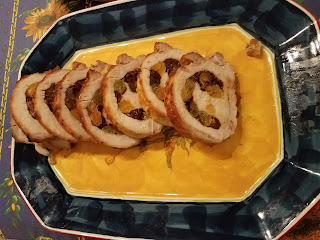A small circle of friends and wine enthusiasts gathered recently for a wine dinner featuring my selection of libations from Oregon and Washington, including a Pinot Gris, an unoaked Chardonnay, and two Pinot Noirs from the former, and a Merlot and a Cabernet Sauvigon from the latter. These wines reflect a snapshot of the leading varietals and strengths of Northwest production at affordable price points. The Westmont Pinot Gris and A to Z Pinot offer especially good values, whereas the Chehalems, Crossfork Creek and Gordon Estate represent a step-up in price and complexity for a more indulgent tasting experience.
Many thanks again to our gracious hosts for the delicious repast featuring tasty cheeses, charcuterie, stuffed pork loin, pasta and broccoli among other mouth-watering comestibles.
All wines were purchased at Total Wine in Delaware, except for the Westmount which I picked up in the Pennsylvania wine and spirits store.
Westmount Pinot Gris 2020 ($15 plus tax)
Origin: Willamette Valley AVA, Oregon
Varietal:
100%
Pinot Gris
Production/Tasting
Notes: Soil composed of glaciatic silt deposits, alluvial
clay; juicy, sappy, lush with ripe citrus and apple fruit with hints of green
melon; crisp acidity; bright, fresh, with palate-cleansing minerality (92 points, Wine Enthusiast)
Food Pairing: seafood, chicken,
soft cheeses - chevre, roquefort
Alcohol:
13.1%
Chehalem
Inox Unoaked Chardonnay 2021 ($21)
Origin:
Willamette
Valley AVA, Oregon
Varietal:
100% Chardonnay
Tasting
Notes: Fermented in 100% stainless steel; aged on the
lees for 2 months before being stabilized and bottled; vibrant, crisp with
delicate aromas of white flowers, fresh honeycomb, pink lady apples; stone
fruit on the mid-palate; silky, balanced finished. (92 points, Wine Enthusiast; 90 points, Wine
Spectator)
Food
pairing: Roast chicken;
butternut squash risotto
Alcohol: 12.5%
A to Z Pinot Noir 2020 ($20)
Origin:
Oregon
Varietal:
100%
Pinot Noir
Tasting
Notes: Organically grown; red fruit aromatics - cherry, plum, cranberry, pomegranate; notes
of spice - clove, turmeric, gingerbread; herbs - thyme, mint, lavender; wood -
spruce, cedar; savory - bacon, mushroom; succulent, round palate; oak profile
of sandalwood, mesquite, vanilla; soft, structured tannins; fresh, balanced
acidity; lingering finish of cherry, purple flower, herbs.
Food Pairing: pork; grilled
duck breast; salmon; pizza
Alcohol: 13.5%
Chehalem Pinot Noir 2019 ($31.49)
Origin:
Chehalem
Mountains AVA, Willamette Valley, Oregon
Varietals:
100%
Pinot Noir
Production/Tasting
Notes: Three to five days of cold maceration; fermented in
stainless steel tanks for 8-14 days; aged in French oak for 10 months (21 new
oak); intense bright red fruit aromatics of strawberries, cranberries, cherry
pie following through on the palate with subtle notes of toasted almonds,
toffee, white pepper spice; juicy, dense palate with silk tannins.
Food
Pairing: coq au vin; roast lamb; osso buco
Alcohol: 12.8%
Crossfork
Creek Merlot 2020 ($27)
Varietals:
100%
Merlot
Production/Tasting
Notes: Notes of black fruit - black currant, wild berry;
dense, layered structure; full bodied
Food
Pairing: Pasta with meaty ragu sauce; ratatouille; chargrilled
meats; tagines
Alcohol: 14%
Gordon Estate Cabernet Sauvignon 2017 ($25)
Origin :
Columbia
Valley, Washington
Varietal:
100%
Cabernet Sauvignon
Production/Tasting Notes: 22 months in 80% neutral French oak and 20% in American neutral oak; hints of cocoa, raspberry, black plum; on the palate a balance of black fruit, wet-stone minerality, savory dried herbs, soft, silky moderate tannins; smooth, toasty lingering finish Food
Pairings: intensely flavored meats; bone-in steak with
mushroom sauce.
Alcohol:
13.8%
















































